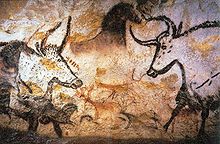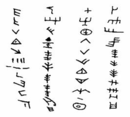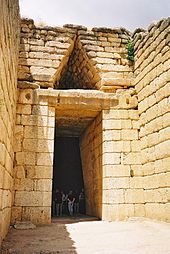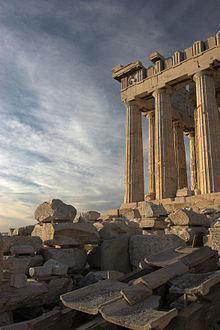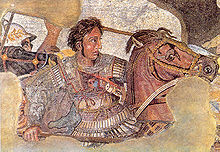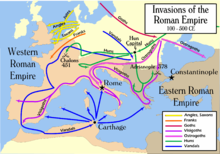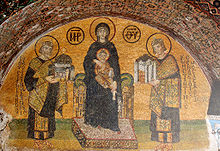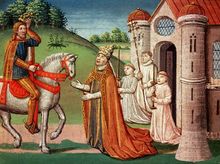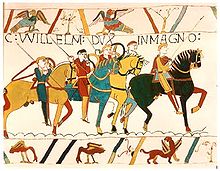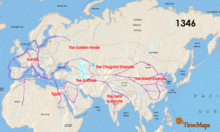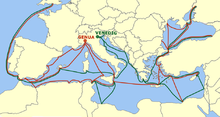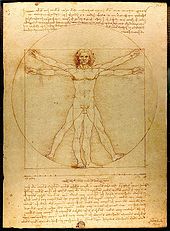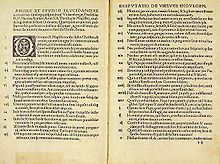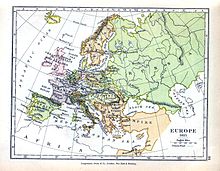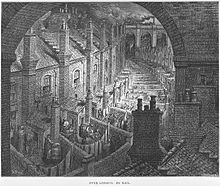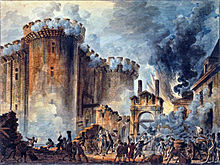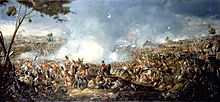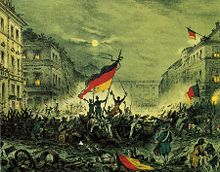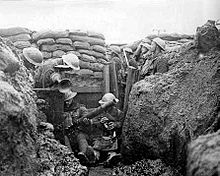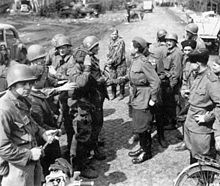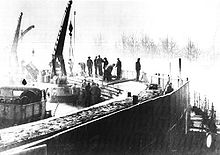- History of Europe
-
History of Europe describes the history of humans inhabiting the European continent since it was first populated in prehistoric times to present, with the first human settlement between 45,000 and 25,000 BC.
Contents
Overview
Greco-Roman civilizations dominated Classical antiquity starting in Ancient Greece, generally considered to be the seminal culture which provided the foundation of Western civilisation and influential on language, politics, educational systems, philosophy, science and the arts, with the writing of the epic Iliad at around 700 BC. Those values were acquired by the Roman Republic established in 509 BC, having expanded from Italy, centred in the Mediterranean Sea, until the Roman Empire reached its greatest extent around the year 150.
After a period of civil wars, emperor Constantine I shifted the capital from Rome to the Greek town Byzantium in 313, then renamed it "the city of Constantine". In 395 the empire was permanently split in two, with the Western Roman Empire repeatedly attacked during the migration period. Rome was sacked in 410 by the Visigoths, the first of the Germanic peoples migrating into Roman territories. With the last West Roman emperor removed in 476, south-eastern Europe and some parts of the Mediterranean remained under the Byzantine Empire up to the later 6th century.
After 1453, when Ottoman Turks captured Constantinople, the name of the city would morph into Istanbul, a Turkification of 'Stamboul', derived from the Greek phrase "εις την Πόλιν" or "στην Πόλη" [istimbolin], meaning "in the city" or "to the city".
As Roman Empire started to become weaker, Bulgars established First Bulgarian Empire next to the north-eastern border of the Roman Empire, and Germanic peoples established kingdoms in territories north to the Empire. The new states shared Latin written language, lingering Roman culture and Christian religion. Much territory was brought under the rule of the Franks by Charlemagne, whom the pope crowned an Emperor in 800, but soon divided while Europe came under attack from Vikings, Muslims from North Africa, and Magyars from Hungary. By the mid-10th century the threat had decreased, although Vikings remained threatening Britain and Ireland.
After the establishment of Constantinople and the creation of a church there, which replaced the pre-existing bishopric of Heracleia nearby, tensions between the new and rapidly growing church and the church of Rome gradually increased, with doctrinal disputes masking the struggle for primacy. One well known instance of such tension (although it did not lead to a formal schism) occurred when in 1054 AD a legate of the pope, Cardinal Humbert, formally excommunicated the patriarch of Constantinople, an excommunication which was repeated against him the following day. However, from 1095 a series of religiously sanctioned military campaigns began to be waged by coalitions of Latin Christian Europeans, in response to a call from the Byzantine Empire, for help against the Muslim expansion. Spain, southern France, First Bulgarian Empire, Lithuania and pagan regions were consolidated during this time, with the Battle of Nicopolis the last large-scale crusade of the Middle Ages fought in 1396. Complex feudal loyalties developed and the aristocracy of new nations become very closely related by intermarriage. The feudal society began to break as Mongol invaded frontier areas and the Black Death pandemic killed from 30% to 60% of Europe's population.[1]
Beginning roughly in the 14th century in Florence, and later spreading through Europe with the development of printing press, a Renaissance of knowledge challenged traditional doctrines in science and theology, with the rediscovery of classical Greek and Roman knowledge. Simultaneously Protestant Reformation under German Martin Luther questioned Papal authority. Henry VIII sundered the English Church, allying in ensuing religious wars between German and Spanish rulers. The Reconquista of Portugal and Spain led to a series of oceanic explorations resulting in the age of discovery that established direct links with Africa, the Americas and Asia, while religious wars continued to be fought in Europe,[2] which ended in 1648 with the Peace of Westphalia.
European overseas expansion led to the rise of colonial empires, producing the Columbian Exchange.[3] The combination of resource inflows from the New World and the Industrial Revolution of Great Britain, allowed a new economy based on manufacturing instead of subsistence agriculture.[4] Starting in 1775, British Empire colonies in America revolted to establish a representative government. Political change in continental Europe was spurred by the French Revolution under the motto liberté, egalité, fraternité. The ensuing French leader, Napoleon Bonaparte, conquered and enforced reforms through war up to 1815.
The period between 1815 and 1871 saw a large number of revolutionary attempts and independence wars. In France and the United Kingdom, socialist and trade union activity developed. The last vestiges of serfdom were abolished in Russia in 1861[5] and Balkan nations began to regain independence from the Ottoman Empire. After the Franco-Prussian War, Germany and Italy unified into nation states, and most European states had become constitutional monarchies by 1871.
Rivalry in a scramble for empires spread. The outbreak of the First World War was precipitated by a series of struggles among the Great Powers. War and poverty triggered the Russian Revolution which led to the formation of the communist Soviet Union. Hard conditions imposed on Germany by the Treaty of Versailles and the Great Depression led to the rise of fascism in Germany as well as in Italy, Spain and other countries. The rise of the irredentist totalitarian regime Nazi Germany led to a Second World War.
Following the end of the Second World War, Europe was divided by the Iron Curtain between American dominated non-socialist countries of Europe and Soviet dominated socialist countries of Europe. Most non-socialist European countries came under US protection via NATO and formed the European Economic Community amongst themselves. The East was dominated by communist countries under the Soviet Union's economic and military leadership. There were also a number of neutral countries in between.
In the late 1989, the Fall of Communism begun in countries allied with USSR: Poland, Hungary and Romania. The Soviet Union itself felt a bit later, in years 1990-1991, and countries which were Soviet republics became independent. As a consequence Europe's economic integration deepened, the continent became depolarised and the European Union expanded to include many of the formerly communist European countries, in 2004 and 2007.
Prehistory
Main articles: Prehistoric Europe, Palaeolithic Europe, Mesolithic Europe, Neolithic Europe, Stone Age, Bronze Age Europe, and Iron age EuropeHomo erectus and Neanderthals migrated from Africa to Europe before the emergence of modern humans. The bones of the earliest Europeans are found in Shkoder, Albania, dated at 1.8 million years ago.
The earliest appearance of anatomically modern people in Europe has been dated to 35,000 BC. Some locally developed transitional cultures (Szletian in Central Europe and Châtelperronian in the Southwest) use clearly Upper Palaeolithic technologies at very early dates and there are doubts about who were their carriers: H. sapiens, Neanderthal or the intermarried population of the same species.[citation needed]
Nevertheless, the definitive advance of these technologies is made by the Aurignacian culture. The origins of this culture can be located in what is now Bulgaria (proto-Aurignacian) and Hungary (first full Aurignacian). By 35,000 BC, the Aurignacian culture and its technology had extended through most of Europe. The last Neanderthals seem to have been forced to retreat during this process to the southern half of the Iberian Peninsula.
Around 24,000 BC two new technologies/cultures appeared in the southwestern region of Europe: Solutrean and Gravettian. The Gravettian technology/culture has been theorised to have come with migrations of people from the Middle East, Anatolia, and the Balkans.
 Map showing the Neolithic expansions from the 7th to the 5th millennium BC, including the Cardium Culture in blue.
Map showing the Neolithic expansions from the 7th to the 5th millennium BC, including the Cardium Culture in blue.
Around 19,000 BC, Europe witnesses the appearance of a new culture, known as Magdalenian, possibly rooted in the old Aurignacian one. This culture soon supersedes the Solutrean area and the Gravettian of mainly France, Spain, Germany, Italy, Poland, Portugal and Ukraine. Around 12,500 BC, the Würm Glacial age ends. Slowly, through the following millennia, temperatures and sea levels rise, changing the environment of prehistoric people. Nevertheless, Magdalenian culture persists until c. 10,000 BC, when it quickly evolves into two microlithist cultures: Azilian, in Spain and southern France, and Sauveterrian, in northern France and Central Europe. Evidence of permanent settlement dates from the 7th millennium BC in the Balkans. The Neolithic reached Central Europe in the 6th millennium BC and parts of Northern Europe in the 5th and 4th millennium BC.
Lepenski Vir - Vinča - Cucuteni cultures 7000 - 2750 BC
Lepenski Vir (Лепенски Вир, Lepen Whirl) is an important Mesolithic archaeological site located in Serbia in the central Balkan peninsula. It consists of one large settlement with around ten satellite villages. The evidence suggests the first human presence in the locality around 7000 BC with the culture reaching its peak between 5300 BC and 4800 BC. In 7000 BC the settlement had a population under 100, In later periods the problems of overpopulation of the original settlement became evident, This is clearly evident in the layout of the Lepenski Vir settlement. The village is well planned. All houses are built according to one complex geometric pattern. 136 buildings, settlements and altars were found in the initial excavations in 1965-1970. The Lepenski Vir culture were a forerunner to the Vinča-Turdaș culture, dated to the period 5500–4500 BC in the same area of the Balkans, during the Vinča era the area sustained population growth led to an unprecedented level of settlement size and density along with the population of areas that were bypassed by earlier settlers. Vinča settlements were considerably larger than any other contemporary European culture, in some instances surpassing the cities of the Aegean and early Near Eastern Bronze Age a millennium later. The largest sites, more than 29 hectares, may have had populations of up to 2,500 individuals.[6] According to Marija Gimbutas, the Vinča culture was part of Old Europe – a relatively homogeneous, peaceful and matrifocal culture that occupied Europe during the Neolithic. According to this theory its period of decline was followed by an invasion of warlike, horse-riding Proto-Indo-European tribes from the Pontic-Caspian steppe.[7] The Vinča site of Pločnik has produced the earliest example of copper tools in the world. Copper ores were mined on a large scale at sites like Rudna Glava, but only a fraction were smelted and cast into metal artefacts – and these were ornaments and trinkets rather than functional tools, which continued to be made from chipped stone, bone and antler. It is likely that the primary use of mined ores was in their powdered form, in the production of pottery or as bodily decoration.[8]
This period is associated with the Vinča symbols, which are conjectured to be an early form of proto-writing alongside with the Dispilio Tablet (5260 BC) from northern Greece not far from The Vinca Culture, the Tărtăria clay tablets dating back to around 5300 BC. This means that the Vinča finds predate the proto-Sumerian pictographic script from Uruk (modern Iraq), which is usually considered as the oldest known script, by more than a thousand years. The Cucuteni-Trypillian culture 5508-2750 BC was the first big civilisation in Europe and among the earliest in the world. it was a late Neolithic archaeological Civilization from the Carpathian Mountains to the Dniester and Dnieper regions in modern-day Romania, Moldova, and Ukraine, encompassing an area of more than 350,000 km2 (140,000 sq mi).[9] At its peak the Cucuteni-Trypillian culture built the largest settlements in Neolithic Europe, some of which had populations of up to 15,000 inhabitants.[10] Likewise, their density was very high, with the settlements averagely spaced 3 to 4 kilometers apart.[11]
Minoans and Mycenae 2700 - 1100 BC
The first well-known literate civilisation in Europe was that of the Minoans, The Minoan civilization was a Bronze Age civilization that arose on the island of Crete and flourished from approximately the 27th century BC to the 15th century BC.[12] It was rediscovered at the beginning of the 20th century through the work of the British archaeologist Arthur Evans. Will Durant referred to it as "the first link in the European chain".[13] Minoan palaces (anaktora) are the best known building types to have been excavated on the island. They are monumental buildings serving administrative purposes as evidenced by the large archives unearthed by archaeologists. Each of the palaces excavated to date has its own unique features, but they also share features which set them apart from other structures. The palaces were often multi-storied, with interior and exterior staircases, light wells, massive columns, storage magazines and courtyards.
The Minoans were replaced by the Mycenaean civilization which flourished during the period roughly between 1600 BC, when Helladic culture in mainland Greece was transformed under influences from Minoan Crete, and 1100 BC. The major Mycenaean cities were Mycenae and Tiryns in Argolis, Pylos in Messenia, Athens in Attica, Thebes and Orchomenus in Boeotia, and Iolkos in Thessaly. In Crete, the Mycenaeans occupied Knossos. Mycenaean settlement sites also appeared in Epirus,[14][15] Macedonia,[16][17] on islands in the Aegean Sea, on the coast of Asia Minor, the Levant,[18] Cyprus[19] and Italy.[20][21] Mycenaean artifacts have been found well outside the limits of the Mycenean world: namely Mycenaean swords are known from as far away as Georgia in the Caucasus,[22] an amber object inscribed with Linear B symbols has been found in Bavaria, Germany[23] and Mycenaean bronze double axes and other objects dating from 13th century BC have been found in Ireland and in Wessex and Cornwall in England.[24][25][26][27] Quite unlike the Minoans, whose society benefited from trade, the Mycenaeans advanced through conquest. Mycenaean civilization was dominated by a warrior aristocracy. Around 1400 BC, the Mycenaeans extended their control to Crete, centre of the Minoan civilization, and adopted a form of the Minoan script (called Linear A) to write their early form of Greek in Linear B.
The Mycenaean civilization perished with the collapse of Bronze-Age civilization in the eastern Mediterranean. The collapse is commonly attributed to the Dorian invasion, although other theories describing natural disasters and climate change have been advanced as well. Whatever the causes, the Mycenaean civilization had definitely disappeared after LH III C, when the sites of Mycenae and Tirynth were again destroyed and lost their importance. This end, during the last years of the 12th century BC, occurs after a slow decline of the Mycenaean civilization, which lasted many years before dying out. The beginning of the 11th century BC opens a new context, that of the protogeometric, the beginning of the geometric period, the Greek Dark Ages of traditional historiography.
Classical Antiquity
The Greeks and the Romans left a legacy in Europe which is evident in current language, thought, law and minds. Ancient Greece was a collection of city-states, out of which the original form of democracy developed. Athens was the most powerful and developed city, and a cradle of learning from the time of Pericles. Citizens forums debated and legislated policy of the state, and from here arose some of the most notable classical philosophers, such as Socrates, Plato, and Aristotle, the last of whom taught Alexander the Great.
The king of the kingdom of Macedon, Alexander's military campaigns spread Hellenistic culture and learning to the banks of the River Indus. But the Roman Republic, strengthened through victory over Carthage in the Punic Wars was rising in the region. Greek wisdom passed into Roman institutions, as Athens itself was absorbed under the banner of the Senate and People of Rome (Senatus Populusque Romanus).
The Romans expanded from Arabia to Britannia. In 44 BC as it approached its height, its leader Julius Caesar was murdered on suspicion of subverting the Republic, to become dictator. In the ensuing turmoil, Octavian usurped the reins of power and fought the Roman Senate. While proclaiming the rebirth of the Republic, he had ushered in the transfer of the Roman state from a republic to an empire, the Roman Empire, which lasted for more than four centuries until the fall of the Western Roman Empire.
Ancient Greece
The Hellenic civilisation took the form of a collection of city-states, or poleis (the most important being Athens, Sparta, Thebes, Corinth, and Syracuse), having vastly differing types of government and cultures, including what are unprecedented developments in various governmental forms, philosophy, science, mathematics, politics, sports, theatre and music.
Athens, the most powerful city-state, governed itself with an early form of direct democracy founded by Athenian noble Cleisthenes. In Athenian democracy, the citizens of Athens themselves voted on legislation and executive bills in their own right. From here arose Socrates, considered one of the founders of Western philosophy.[28]
Socrates also created the Socratic Method, or elenchus, a type of pedagogy used to this day in philosophical teaching, in which a series of questions are asked not only to draw individual answers, but to encourage fundamental insight into the issue at hand. Due to this philosophy, Socrates was put on trial and sentenced to death for "corrupting the youth" of Athens, as his discussions conflicted with the established religious beliefs of the time. Plato, a pupil of Socrates and founder of the Platonic Academy, recorded this episode in his writings, and went on to develop his own unique philosophy, Platonism.
The Hellenic city-states founded a large number of colonies on the shores of the Black Sea and the Mediterranean sea, Asia Minor, Sicily and Southern Italy in Magna Graecia, but in the 5th century BC their eastward expansions led to retaliation from the Achaemenid Persian Empire. In the Greco-Persian Wars, the Hellenic city-states formed an alliance and defeated the Persian Empire at the Battle of Plataea, repelling the Persian invasions.
The Greeks formed the Delian League to continue fighting Persia, but Athens' position as leader of this league led to Sparta forming the rival Peloponnesian League. The two leagues began the Peloponnesian War over leadership of Greece, leaving the Peloponnesian League as the victor. Discontent with the Spartan hegemony that followed led to the Corinthian War where an alliance led by Thebes crushed Sparta at the Battle of Leuctra.
Continued Hellenic infighting made Greek city states easy prey for king Philip II of Macedon, who united all the Greek city states. The campaigns of his son Alexander the Great spread Greek culture into Persia, Egypt and India, but also favoured contact with the older learnings of those countries, opening up a new period of development, known as Hellenism. Alexander died in 323 BC, splitting his empire into many Hellenistic civilisations.
The rise of Rome
 Cicero addresses the Roman Senate to denounce Catiline's conspiracy to overthrow the Republic, by Cesare Maccari
Cicero addresses the Roman Senate to denounce Catiline's conspiracy to overthrow the Republic, by Cesare Maccari
Much of Greek learning was assimilated by the nascent Roman state as it expanded outward from Italy, taking advantage of its enemies' inability to unite: the only challenge to Roman ascent came from the Phoenician colony of Carthage, and its defeats in the three Punic Wars marked the start of Roman hegemony. First governed by kings, then as a senatorial republic (the Roman Republic), Rome finally became an empire at the end of the 1st century BC, under Augustus and his authoritarian successors.
The Roman Empire had its centre in the Mediterranean Sea, controlling all the countries on its shores; the northern border was marked by the Rhine and Danube rivers. Under emperor Trajan (2nd century AD) the empire reached its maximum expansion, controlling approximately 5,900,000 km2 (2,300,000 sq mi) of land surface, including Britain, Romania and parts of Mesopotamia. A period of peace, civilisation and an efficient centralised government in the subject territories ended in the 3rd century, when a series of civil wars undermined Rome's economic and social strength.
In the 4th century, the emperors Diocletian and Constantine were able to slow down the process of decline by splitting the empire into a Western part with a capital in Rome and an Eastern part with the capital in Byzantium, or Constantinople. Whereas Diocletian severely persecuted Christianity, Constantine declared an official end to state-sponsored persecution of Christians in 313 with the Edict of Milan, thus setting the stage for the Church to become the State church of the Roman Empire in about 380.
Decline of the Roman Empire
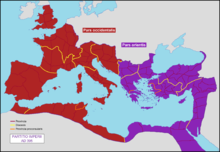 Map of the Roman Empire partition in 395, at the death of Theodosius I: the Western (red) and Eastern Roman Empire (Byzantine Empire) (purple).
Map of the Roman Empire partition in 395, at the death of Theodosius I: the Western (red) and Eastern Roman Empire (Byzantine Empire) (purple).
The Roman Empire had been repeatedly attacked by invading armies from Northern Europe and in 476, Rome finally fell. Romulus Augustus, the last Emperor of the Western Roman Empire surrendered to the Germanic King Odoacer. British historian Edward Gibbon argued in The Decline and Fall of the Roman Empire (1776) that the Romans had become decadent, they had lost civic virtue.
Gibbon said that the adoption of Christianity, meant belief in a better life after death, and therefore made people lazy and indifferent to the present. "From the eighteenth century onward", Glen W. Bowersock has remarked,[29] "we have been obsessed with the fall: it has been valued as an archetype for every perceived decline, and, hence, as a symbol for our own fears." It remains one of the greatest historical questions, and has a tradition rich in scholarly interest.
Some other notable dates are the Battle of Adrianople in 378, the death of Theodosius I in 395 (the last time the Roman Empire was politically unified), the crossing of the Rhine in 406 by Germanic tribes after the withdrawal of the legions in order to defend Italy against Alaric I, the death of Stilicho in 408, followed by the disintegration of the western legions, the death of Justinian I, the last Roman Emperor who tried to reconquer the west, in 565, and the coming of Islam after 632. Many scholars maintain that rather than a "fall", the changes can more accurately be described as a complex transformation.[30] Over time many theories have been proposed on why the Empire fell, or whether indeed it fell at all.
Late Antiquity and Migration period
When Emperor Constantine had reconquered Rome under the banner of the cross in 312, he soon afterwards issued the Edict of Milan in 313, declaring the legality of Christianity in the Roman Empire. In addition, Constantine officially shifted the capital of the Roman Empire from Rome to the Greek town of Byzantium, which he renamed Constantinople ("City of Constantine").
In 395 Theodosius I, who had made Christianity the official religion of the Roman Empire, would be the last emperor to preside over a united Roman Empire, and from thenceforth, the empire would be split into two halves: the Western Roman Empire centred in Ravenna, and the Eastern Roman Empire (later to be referred to as the Byzantine Empire) centred in Constantinople. The Western Roman Empire was repeatedly attacked by marauding Germanic tribes (see: Migration Period), and in 476 finally fell to the Heruli chieftain Odoacer.
Roman authority in the West completely collapsed and the western provinces soon became a patchwork of Germanic kingdoms. However, the city of Rome, under the guidance of the Roman Catholic Church, still remained a centre of learning, and did much to preserve classic Roman thought in Western Europe. In the meantime, the Roman emperor in Constantinople, Justinian I, had succeeded in codifying all Roman law into the Corpus Juris Civilis (529-534).
For the duration of the 6th century, the Eastern Roman Empire was embroiled in a series of deadly conflicts, first with the Persian Sassanid Empire (see Roman-Persian Wars), followed by the onslaught of the arising Islamic Caliphate (Rashidun and Umayyad). By 650, the provinces of Egypt, Palestine and Syria were lost to the Muslim forces, followed by Hispania and southern Italy in the 7th and 8th centuries (see Muslim conquests). The Arab invasion from the east was stopped after the intervention of Bulgarian Empire (see Tervel of Bulgaria).
In Western Europe, a political structure was emerging: in the power vacuum left in the wake of Rome's collapse, localised hierarchies were based on the bond of common people to the land on which they worked. Tithes were paid to the lord of the land, and the lord owed duties to the regional prince. The tithes were used to pay for the state and wars.
This was the feudal system, in which new princes and kings arose, the greatest of which was the Frank ruler Charlemagne. In 800, Charlemagne, reinforced by his massive territorial conquests, was crowned Emperor of the Romans (Imperator Romanorum) by Pope Leo III, effectively solidifying his power in western Europe.
Charlemagne's reign marked the beginning of a new Germanic Roman Empire in the west, the Holy Roman Empire. Outside his borders, new forces were gathering. The Kievan Rus' were marking out their territory, a Great Moravia was growing, while the Angles and the Saxons were securing their borders.
Middle Ages
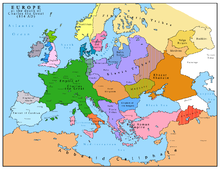 Map of Europe in 814, as the Frankish reached their peak, while Byzantium faced the islamic conquest
Map of Europe in 814, as the Frankish reached their peak, while Byzantium faced the islamic conquest
The Middle Ages are commonly dated from the fall of the Western Roman Empire (or by some scholars, before that) in the 5th century to the beginning of the Early Modern Period in the 16th century, marked by the rise of nation-states, the division of Western Christianity in the Reformation, the rise of humanism in the Italian Renaissance, and the beginnings of European overseas expansion which allowed for the Columbian Exchange.[31]
The Middle Ages witnessed the first sustained urbanisation of northern and western Europe. Many modern European states owe their origins to events unfolding in the Middle Ages; present European political boundaries are, in many regards, the result of the military and dynastic achievements during this tumultuous period.
Byzantium
Many consider Emperor Constantine I (reigned 306–337) to be the first "Byzantine Emperor". It was he who moved the imperial capital in 324 from Nicomedia to Byzantium, re-founded as Constantinople, or Nova Roma ("New Rome").[32] The city of Rome itself had not served as the capital since the reign of Diocletian. Some date the beginnings of the Empire to the reign of Theodosius I (379–395) and Christianity's official supplanting of the pagan Roman religion, or following his death in 395, when the political division between East and West became permanent. Others place it yet later in 476, when Romulus Augustulus, traditionally considered the last western Emperor, was deposed, thus leaving sole imperial authority with the emperor in the Greek East. Others point to the reorganisation of the empire in the time of Heraclius (c. 620) when Latin titles and usages were officially replaced with Greek versions. In any case, the changeover was gradual and by 330, when Constantine inaugurated his new capital, the process of hellenization and increasing Christianisation was already under way. The Empire is generally considered to have ended after the fall of Constantinople to the Ottoman Turks in 1453. The Plague of Justinian was a pandemic that afflicted the Byzantine Empire, including its capital Constantinople, in the years 541–542. It is estimated that the Plague of Justinian killed as many as 100 million people across the world.[33][34] It caused Europe's population to drop by around 50% between 541 and 700.[35] It also may have contributed to the success of the Arab conquests.[36][37]
Early Middle Ages
The Early Middle Ages span roughly five centuries from 500 to 1000.[38] During this period, most of Europe was Christianised, and the "Dark Ages" following the fall of Rome took place. The establishment of the Frankish Empire by the 9th century led to the Carolingian Renaissance on the continent. Europe still remained a backwater compared to the rising Muslim world, with its vast network of caravan trade, or India with its Golden Period under the Gupta Empire and the Pratiharas or China, at this time the world's most populous empire under the Song Dynasty. By AD 1000, Constantinople had a population of about 300,000, but Rome had a mere 35,000 and Paris 20,000. Islam had over a dozen major cities stretching from Córdoba, Spain, at this time the world's largest city with 450,000 inhabitants, to central Asia.
Feudal Christendom
Main articles: Holy Roman Empire, Charlemagne, Caliphate of Córdoba, Bulgarian Empire, Medieval England, Medieval Hungary, Medieval Poland, and Kievan Rus'The Holy Roman Empire emerged around 800, as Charlemagne, king of the Franks, was crowned by the pope as emperor. His empire based in modern France, the Low Countries and Germany expanded into modern Hungary, Italy, Bohemia, Lower Saxony and Spain. He and his father received substantial help from an alliance with the Pope, who wanted help against the Lombards. The pope was officially a vassal of the Byzantine Empire, but the Byzantine emperor did (could do) nothing against the Lombards.
To the east, Bulgaria was established in 681 and became the first Slavic country. The powerful Bulgarian Empire was the main rival of Byzantium for control of the Balkans for centuries and from the 9th century became the cultural centre of Slavic Europe. The Empire created the Cyrillic alphabet during the 10th century AD, at the Preslav Literary School. Two states, Great Moravia and Kievan Rus', emerged among the Slavic peoples respectively in the 9th century. In the late 9th and 10th centuries, northern and western Europe felt the burgeoning power and influence of the Vikings who raided, traded, conquered and settled swiftly and efficiently with their advanced sea-going vessels such as the longships. The Hungarians pillaged mainland Europe, the Pechenegs raided Bulgaria, Rus States and the Arab states. In the 10th century independent kingdoms were established in Central Europe, for example, Poland and Kingdom of Hungary. Hungarians had stopped their pillaging campaigns; prominent also included Croatia and Serbia in the Balkans. The subsequent period, ending around 1000, saw the further growth of feudalism, which weakened the Holy Roman Empire.
High Middle Ages
The slumber of the Dark Ages was shaken by renewed crisis in the Church. In 1054, the East–West Schism, an insoluble split, occurred between the two remaining Christian seats in Rome and Constantinople.
The High Middle Ages of the 11th, 12th, and 13th centuries show a rapidly increasing population of Europe, which caused great social and political change from the preceding era. By 1250, the robust population increase greatly benefited the economy, reaching levels it would not see again in some areas until the 19th century. From about the year 1000 onwards, Western Europe saw the last of the barbarian invasions and became more politically organised. The Vikings had settled in Britain, Ireland, France and elsewhere, whilst Norse Christian kingdoms were developing in their Scandinavian homelands. The Magyars had ceased their expansion in the 10th century, and by the year 1000, the Roman Catholic Apostolic Kingdom of Hungary was recognised in central Europe. With the brief exception of the Mongol invasions, major barbarian incursions ceased.
In the 11th century, populations north of the Alps began to settle new lands, some of which had reverted to wilderness after the end of the Roman Empire. In what is known as the "great clearances," vast forests and marshes of Europe were cleared and cultivated. At the same time settlements moved beyond the traditional boundaries of the Frankish Empire to new frontiers in Europe, beyond the Elbe River, tripling the size of Germany in the process. Crusaders founded European colonies in the Levant, the majority of the Iberian Peninsula was conquered from the Moors, and the Normans colonised southern Italy, all part of the major population increase and resettlement pattern.
The High Middle Ages produced many different forms of intellectual, spiritual and artistic works. This age saw the rise of modern nation-states in Western Europe and the ascent of the great Italian city-states. The still-powerful Roman Church called armies from across Europe to a series of Crusades against the Seljuq Turks, who occupied the Holy Land. The rediscovery of the works of Aristotle led Thomas Aquinas and other thinkers to develop the philosophy of Scholasticism. In architecture, many of the most notable Gothic cathedrals were built or completed during this era.
A divided church
The Great Schism between the Western (Catholic) and Eastern (Orthodox) Christian Churches was sparked in 1054 by Pope Leo IX asserting authority over three of the seats in the Pentarchy, in Antioch, Jerusalem and Alexandria. Since the mid-8th century, the Byzantine Empire's borders had been shrinking in the face of Islamic expansion. Antioch had been wrested back into Byzantine control by 1045, but the resurgent power of the Roman successors in the West claimed a right and a duty for the lost seats in Asia and Africa. Pope Leo sparked a further dispute by defending the filioque clause in the Nicene Creed which the West had adopted customarily. Eastern Orthodox today state that the XXVIII-th Canon of the Fourth Ecumenical Council explicitly proclaimed the equality of the Bishops of Rome and Constantinople. The Orthodox also state that the Bishop of Rome has authority only over his own diocese and does not have any authority outside his diocese. There were other less significant catalysts for the Schism however, including variance over liturgical. The Schism of Roman Catholic and Eastern Orthodox followed centuries of estrangement between Latin and Greek worlds.
Further changes were set afoot with a redivision of power in Europe. William the Conqueror, a Duke of Normandy invaded England in 1066. The Norman Conquest was a pivotal event in English history for several reasons. This linked England more closely with continental Europe through the introduction of a Norman aristocracy, thereby lessening Scandinavian influence. It created one of the most powerful monarchies in Europe and engendered a sophisticated governmental system. Being based on an island, moreover, England was to develop a powerful navy and trade relationships that would come to constitute a vast part of the world including India, Australia, New Zealand, Canada and many key naval strategic points like Bermuda, Suez, Hong Kong and especially Gibraltar. These strategic advantages grew and were to prove decisive until after the Second World War.
Holy wars
After the East-West Schism, Western Christianity was adopted by newly created kingdoms of Central Europe: Poland, Hungary and Bohemia. The Roman Catholic Church developed as a major power, leading to conflicts between the Pope and Emperor. In 1129 AD the Roman Catholic Church established the Inquisition to make Western Europeans Roman Catholic by force. The Inquisition punished those who practised heresy (heretics) to make them repent. If they could not do so, the penalty was death. During this time many Lords and Nobles ruled the church. The Monks of Cluny worked hard to establish a church where there were no Lords or Nobles ruling it. They succeeded. Pope Gregory VII continued the work of the monks with 2 main goals, to rid the church of control by kings and nobles and to increase the power of the pope. The area of the Roman Catholic Church expanded enormously due to conversions of pagan kings (Scandinavia, Lithuania, Poland, Hungary), Christian reconquista of Al-Andalus, and crusades. Most of Europe was Roman Catholic in the 15th century.
Early signs of the rebirth of civilisation in western Europe began to appear in the 11th century as trade started again in Italy, leading to the economic and cultural growth of independent city states such as Venice and Florence; at the same time, nation-states began to take form in places such as France, England, Spain, and Portugal, although the process of their formation (usually marked by rivalry between the monarchy, the aristocratic feudal lords and the church) actually took several centuries. These new nation-states began writing in their own cultural vernaculars, instead of the traditional Latin. Notable figures of this movement would include Dante Alighieri and Christine de Pisan (born Christina da Pizzano), the former writing in Italian, and the latter although an Italian (Venice) relocated to France, writing in French.(See Reconquista for the latter two countries.) On the other hand, the Holy Roman Empire, essentially based in Germany and Italy, further fragmented into a myriad of feudal principalities or small city states, whose subjection to the emperor was only formal.
The 13th and 14th century, when the Mongol Empire came to power, is often called the Age of the Mongols. Mongol armies expanded westward under the command of Batu Khan. Their western conquests included almost all of Russia (save Novgorod, which became a vassal),[39] Kipchak lands, Hungary, and Poland (Which had remained sovereign state). Mongolian records indicate that Batu Khan was planning a complete conquest of the remaining European powers, beginning with a winter attack on Austria, Italy and Germany, when he was recalled to Mongolia upon the death of Great Khan Ögedei. Most historians believe only his death prevented the complete conquest of Europe[citation needed]. In Russia, the Mongols of the Golden Horde ruled for almost 250 years.
Late Middle Ages
The Late Middle Ages span the 14th and 15th centuries. Around 1300, centuries of European prosperity and growth came to a halt. A series of famines and plagues, such as the Great Famine of 1315–1317 and the Black Death, reduced the population by as much as half according to some estimates. Along with depopulation came social unrest and endemic warfare. France and England experienced serious peasant risings: the Jacquerie, the Peasants' Revolt, and the Hundred Years' War. To add to the many problems of the period, the unity of the Catholic Church was shattered by the Great Schism. Collectively these events are sometimes called the Crisis of the Late Middle Ages.[40]
Beginning in the 14th century, the Baltic Sea became one of the most important trade routes. The Hanseatic League, an alliance of trading cities, facilitated the absorption of vast areas of Poland, Lithuania and other Baltic countries into trade with other European countries. This fed the growth of powerful states in this part of Europe including Poland-Lithuania, Hungary, Bohemia, and Muscovy later on. The conventional end of the Middle Ages is usually associated with the fall of the city Constantinople and of the Byzantine Empire to the Ottoman Turks in 1453. The Turks made the city the capital of their Ottoman Empire, which lasted until 1922 and included Egypt, Syria and most of the Balkans. The Ottoman wars in Europe, also sometimes referred as the Turkish wars, marked an essential part of the history of the continent as a whole.
- Hanseatic League, Marco Polo, Lex Mercatoria, History of trade
- Western Schism (1378–1417)
- Hundred Years War, Joan of Arc
Early Modern Europe
The Early Modern period spans the centuries between the Middle Ages and the Industrial Revolution, roughly from 1500 to 1800, or from the discovery of the New World in 1492 to the French Revolution in 1789. The period is characterised by the rise to importance of science and increasingly rapid technological progress, secularised civic politics and the nation state. Capitalist economies began their rise, beginning in northern Italian republics such as Genoa. The early modern period also saw the rise and dominance of the economic theory of mercantilism. As such, the early modern period represents the decline and eventual disappearance, in much of the European sphere, of feudalism, serfdom and the power of the Catholic Church. The period includes the Protestant Reformation, the disastrous Thirty Years' War, the European colonisation of the Americas and the European witch-hunts.
Renaissance
Despite these crises, the 14th century was also a time of great progress within the arts and sciences. A renewed interest in ancient Greek and Roman texts led to what has later been termed the Italian Renaissance.
The Renaissance was a cultural movement that profoundly affected European intellectual life in the early modern period. Beginning in Italy, and spreading to the north and west during a cultural lag of some two and a half centuries, its influence affected literature, philosophy, art, politics, science, history, religion, and other aspects of intellectual enquiry.
The Italian Petrarch (Francesco di Petracco), deemed the first full-blooded Humanist, wrote in the 1330s: "I am alive now, yet I would rather have been born in another time." He was enthusiastic about Greek and Roman antiquity. In the 15th and 16th centuries the continuing enthusiasm for the ancients was reinforced by the feeling that the inherited culture was dissolving and here was a storehouse of ideas and attitudes with which to rebuild. Matteo Palmieri wrote in the 1430s: "Now indeed may every thoughtful spirit thank god that it has been permitted to him to be born in a new age." The renaissance was born: a new age where learning was very important.
The Renaissance was inspired by the growth in study of Latin and Greek texts and the admiration of the Greco-Roman era as a golden age. This prompted many artists and writers to begin drawing from Roman and Greek examples for their works, but there was also much innovation in this period, especially by multi-faceted artists such as Leonardo da Vinci. Many Roman and Greek texts were already in existence in the European Middle Ages. The monks had copied and recopied the old texts and housed them for a millennium, but they had regarded them in another light. Many more flowed in with the migration of Greek scholars and texts to Italy following the Fall of Constantinople while other Greek and Roman texts came from Islamic sources, who had inherited the ancient Greek and Roman texts and knowledge through conquest, even attempting to improve upon some of them.[citation needed] With the usual pride of advanced thinkers, the Humanists saw their repossession of a great past as a Renaissance—a rebirth of civilisation itself.
Important political precedents were also set in this period. Niccolò Machiavelli's political writing in The Prince influenced later absolutism and real-politik. Also important were the many patrons who ruled states and used the artistry of the Renaissance as a sign of their power.
In all, the Renaissance could be viewed as an attempt by intellectuals to study and improve the secular and worldly, both through the revival of ideas from antiquity, and through novel approaches to thought—the immediate past being too "Gothic" in language, thought and sensibility.
Exploration and trade
Toward the end of the period, an era of discovery began. The growth of the Ottoman Empire, culminating in the fall of Constantinople in 1453, cut off trading possibilities with the east. Europeans were forced to discover new trading routes, as happened with Columbus’s travel to the Americas in 1492, and Vasco da Gama’s circumnavigation of India and Africa in 1498.
The numerous wars did not prevent European states from exploring and conquering wide portions of the world, from Africa to Asia and the newly discovered Americas. In the 15th century, Portugal led the way in geographical exploration along the coast of Africa in search for a maritime route to India, followed by Spain near the close of the 15th century; dividing their exploration of world according to the Treaty of Tordesillas of 1494.[41] They were the first states to set up colonies in America and trading posts (factories) along the shores of Africa and Asia, establishing the first direct European diplomatic contacts with Southeast Asian states in 1511, China in 1513 and Japan in 1542. In 1552, Russian tsar Ivan the Terrible conquered two major Tatar khanates, Kazan and Astrakhan, and the Yermak's voyage of 1580 led to the annexation of Siberia into Russia. Oceanic explorations were soon followed by France, England and the Netherlands, who explored the Portuguese and Spanish trade routes into the Pacific Ocean, reaching Australia in 1606[42] and New Zealand in 1642.
Reformation
Spreading through Europe with the development of printing press, knowledge challenged traditional doctrines in science and theology. Simultaneously Protestant Reformation under German Martin Luther questioned Papal authority. The most common dating begins in 1517, when Luther published The Ninety-Five Theses, and concludes in 1648 with the Treaty of Westphalia that ended years of European religious wars.[43]
During this period corruption in the Catholic Church led to a sharp backlash in the Protestant Reformation. It gained many followers especially among princes and kings seeking a stronger state by ending the influence of the Catholic Church. Figures other than Martin Luther began to emerge as well like John Calvin whose Calvinism had influence in many countries and King Henry VIII of England who broke away from the Catholic Church in England and set up the Anglican Church (contrary to popular belief, this is only half true; his daughter Queen Elizabeth finished the organization of the church). These religious divisions brought on a wave of wars inspired and driven by religion but also by the ambitious monarchs in Western Europe who were becoming more centralised and powerful.
The Protestant Reformation also led to a strong reform movement in the Catholic Church called the Counter-Reformation, which aimed to reduce corruption as well as to improve and strengthen Catholic Dogma. Two important groups in the Catholic Church who emerged from this movement were the Jesuits, who helped keep Spain, Portugal, Poland and other European countries within the Catholic fold, and the Oratorians of St Philip Neri, who ministered to the faithful in Rome, restoring their confidence in the Church of Jesus Christ that subsisted substantially in the Church of Rome. Still, the Catholic Church was somewhat weakened by the Reformation, portions of Europe were no longer under its sway and kings in the remaining Catholic countries began to take control of the Church institutions within their kingdoms.
Unlike many European counties, the Polish–Lithuanian Commonwealth and Hungary, were more tolerant. While still enforcing the predominance of Catholicism they continued to allow the large religious minorities to maintain their faiths, traditions and customs. Polish–Lithuanian Commonwealth became divided between Catholics, Protestants, Orthodox, Jews and a small Muslim population.
Another important development in this period was the growth of pan-European sentiments. Eméric Crucé (1623) came up with the idea of the European Council, intended to end wars in Europe; attempts to create lasting peace were no success, although all European countries (except the Russian and Ottoman Empires, regarded as foreign) agreed to make peace in 1518 at the Treaty of London. Many wars broke out again in a few years. The Reformation also made European peace impossible for many centuries.
Another development was the idea of 'European superiority'. The ideal of civilisation was taken over from the ancient Greeks and Romans: discipline, education and living in the city were required to make people civilised; Europeans and non-Europeans were judged for their civility, and Europe regarded itself as superior to other continents. There was a movement by some such as Montaigne that regarded the non-Europeans as a better, more natural and primitive people. Post services were founded all over Europe, which allowed a humanistic interconnected network of intellectuals across Europe, despite religious divisions. However, the Roman Catholic Church banned many leading scientific works; this led to an intellectual advantage for Protestant countries, where the banning of books was regionally organised. Francis Bacon and other advocates of science tried to create unity in Europe by focusing on the unity in nature.1 In the 15th century, at the end of the Middle Ages, powerful sovereign states were appearing, built by the New Monarchs who were centralising power in France, England, and Spain. On the other hand the Parliament in the Polish–Lithuanian Commonwealth grew in power, taking legislative rights from the Polish king. The new state power was contested by parliaments in other countries especially England. New kinds of states emerged which were cooperation agreements between territorial rulers, cities, farmer republics and knights.
Mercantilism and colonial expansion
The Iberian states (Spain and Portugal) were able to dominate New World (American) colonial activity in the 16th century but were increasingly challenged by British, French, and the short-lived Dutch and Swedish colonial efforts of the 17th and 18th centuries. New forms of trade and expanding horizons made new forms of government, law and economics necessary.
Colonial expansion continued in the following centuries (with some setbacks, such as successful wars of independence in the British American colonies and then later Mexico, Argentina, Brazil, and others following French occupation of Spain in the Napoleonic Wars). Spain had control of a large part of North America, all of Central America and a great part of South America, the Caribbean and the Philippines; Britain took the whole of Australia and New Zealand, most of India, and large parts of Africa and North America; France held parts of Canada and India (nearly all of which was lost to Britain in 1763), Indochina, large parts of Africa and Caribbean islands; the Netherlands gained the East Indies (now Indonesia) and islands in the Caribbean; Portugal obtained Brazil and several territories in Africa and Asia; and later, powers such as Germany, Belgium, Italy and Russia acquired further colonies.
This expansion helped the economy of the countries owning them. Trade flourished, because of the minor stability of the empires. By the late 16th century American silver accounted for one-fifth of the Spain's total budget.[44] The European countries fought wars that were largely paid for by the money coming in from the colonies. Nevertheless, the profits of the slave trade and of plantations of the West Indies, then the most profitable of all the British colonies, amounted to less than 5% of the British Empire's economy (but was generally more profitable) at the time of the Industrial Revolution in the late 18th century.
Enlightenment
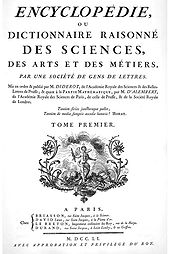 The Encyclopédie published in France in 1751, presented a taxonomy of human knowledge inspired by Francis Bacon
The Encyclopédie published in France in 1751, presented a taxonomy of human knowledge inspired by Francis Bacon
Throughout the early part of this period, capitalism (through Mercantilism) was replacing feudalism as the principal form of economic organisation, at least in the western half of Europe. The expanding colonial frontiers resulted in a Commercial Revolution. The period is noted for the rise of modern science and the application of its findings to technological improvements, which culminated in the Industrial Revolution.
The Reformation had profound effects on the unity of Europe. Not only were nations divided one from another by their religious orientation, but some states were torn apart internally by religious strife, avidly fostered by their external enemies. France suffered this fate in the 16th century in the series of conflicts known as the French Wars of Religion, which ended in the triumph of the Bourbon Dynasty. England avoided this fate for a while and settled down under Elizabeth to a moderate Anglicanism. Much of modern day Germany was made up of numerous small sovereign states under the theoretical framework of the Holy Roman Empire, which was further divided along internally drawn sectarian lines. The Polish–Lithuanian Commonwealth is notable in this time for its religious indifference and a general immunity to the horrors of European religious strife.
The Thirty Years' War was fought between 1618 and 1648, principally on the territory of today's Germany, and involved most of the major European powers. Beginning as a religious conflict between Protestants and Catholics in Bohemia, it gradually developed into a general war involving much of Europe, for reasons not necessarily related to religion.[45] The major impact of the war, in which mercenary armies were extensively used, was the devastation of entire regions scavenged bare by the foraging armies. Episodes of widespread famine and disease devastated the population of the German states and, to a lesser extent, the Low Countries, Bohemia and Italy, while bankrupting many of the regional powers involved. Between one-fourth and one-third of the German population perished from direct military causes or from illness and starvation related to the war.[46] The war lasted for thirty years, but the conflicts that triggered it continued unresolved for a much longer time.
After the Peace of Westphalia which ended the war in favour of nations deciding their own religious allegiance, Absolutism became the norm of the continent, while parts of Europe experimented with constitutions foreshadowed by the English Civil War and particularly the Glorious Revolution. European military conflict did not cease, but had less disruptive effects on the lives of Europeans. In the advanced northwest, the Enlightenment gave a philosophical underpinning to the new outlook, and the continued spread of literacy, made possible by the printing press, created new secular forces in thought. Again, the Polish–Lithuanian Commonwealth would be an exception to this rule, with its unique quasi-democratic Golden Freedom.
Europe in 16th and 17th century was an arena of conflict for domination in the continent between Sweden, the Polish–Lithuanian Commonwealth and the Ottoman Empire. This period saw a gradual decline of these three powers which were eventually replaced by new enlightened absolutist monarchies, Russia, Prussia and Austria. By the turn of the 19th century they became new powers, having divided Poland between them, with Sweden and Turkey having experienced substantial territorial losses to Russia and Austria respectively as well as pauperisation. Numerous Polish Jews emigrated to France, Germany and America, founding Jewish communities in places where they had been expelled from during the Middle Ages.
From revolution to imperialism
The "long nineteenth century", from 1789 to 1914 sees the drastic social, political and economic changes initiated by the Industrial Revolution, the French Revolution and the Napoleonic Wars, and following the reorganisation of the political map of Europe at the Congress of Vienna in 1815, the rise of Nationalism, the rise of the Russian Empire and the peak of the British Empire, paralleled by the decline of the Ottoman Empire. Finally, the rise of the German Empire and the Austro-Hungarian Empire initiated the course of events that culminated in the outbreak of the First World War in 1914.
Industrial Revolution
The Industrial Revolution was a period in the late 18th century and early 19th century when major changes in agriculture, manufacturing, and transport affected socioeconomic and cultural conditions in Britain and subsequently spread throughout Europe and North America and eventually the world, a process that continues as industrialisation. In the later part of the 18th century the manual labour based economy of the Kingdom of Great Britain began to be replaced by one dominated by industry and the manufacture of machinery. It started with the mechanisation of the textile industries, the development of iron-making techniques and the increased use of refined coal. Once started it spread. Trade expansion was enabled by the introduction of canals, improved roads and railways. The introduction of steam power (fuelled primarily by coal) and powered machinery (mainly in textile manufacturing) underpinned the dramatic increases in production capacity.[47] The development of all-metal machine tools in the first two decades of the 19th century facilitated the manufacture of more production machines for manufacturing in other industries. The effects spread throughout Western Europe and North America during the 19th century, eventually affecting most of the world. The impact of this change on society was enormous.[48]
See also: Steam engine, Adam Smith, Jeremy Bentham, John Stuart Mill, Karl Marx, History of economic thought, and History of rail transportPolitical revolution
French intervention in the American Revolutionary War had bankrupted the state. After repeated failed attempts at financial reform, Louis XVI was persuaded to convene the Estates-General, a representative body of the country made up of three estates: the clergy, the nobility, and the commoners. The members of the Estates-General assembled in the Palace of Versailles in May 1789, but the debate as to which voting system should be used soon became an impasse. Come June, the third estate, joined by members of the other two, declared itself to be a National Assembly and swore an oath not to dissolve until France had a constitution and created, in July, the National Constituent Assembly. At the same time the people of Paris revolted, famously storming the Bastille prison on 14 July 1789.
At the time the assembly wanted to create a constitutional monarchy, and over the following two years passed various laws including the Declaration of the Rights of Man and of the Citizen, the abolition of feudalism, and a fundamental change in the relationship between France and Rome. At first the king agreed with these changes and enjoyed reasonable popularity with the people, but as anti-royalism increased along with threat of foreign invasion, the king, stripped of his power, decided to flee along with his family. He was recognised and brought back to Paris. On 12 January 1793, having been convicted of treason, he was executed.
On 20 September 1792 the National Convention abolished the monarchy and declared France a republic. Due to the emergency of war the National Convention created the Committee of Public Safety, controlled by Maximilien Robespierre of the Jacobin Club, to act as the country's executive. Under Robespierre the committee initiated the Reign of Terror, during which up to 40,000 people were executed in Paris, mainly nobles, and those convicted by the Revolutionary Tribunal, often on the flimsiest of evidence. Elsewhere in the country, counter-revolutionary insurrections were brutally suppressed. The regime was overthrown in the coup of 9 Thermidor (27 July 1794) and Robespierre was executed. The regime which followed ended the Terror and relaxed Robespierre's more extreme policies.
Napoleon Bonaparte was France's most successful general in the Revolutionary wars, having conquered large parts of Italy and forced the Austrians to sue for peace. In 1799 he returned from Egypt and on 18 Brumaire (9 November) overthrew the government, replacing it with the Consulate, in which he was First Consul. On 2 December 1804, after a failed assassination plot, he crowned himself Emperor. In 1805, Napoleon planned to invade Britain, but a renewed British alliance with Russia and Austria (Third Coalition), forced him to turn his attention towards the continent, while at the same time failure to lure the superior British fleet away from the English Channel, ending in a decisive French defeat at the Battle of Trafalgar on 21 October put an end to hopes of an invasion of Britain. On 2 December 1805, Napoleon defeated a numerically superior Austro-Russian army at Austerlitz, forcing Austria's withdrawal from the coalition (see Treaty of Pressburg) and dissolving the Holy Roman Empire. In 1806, a Fourth Coalition was set up. On 14 October Napoleon defeated the Prussians at the Battle of Jena-Auerstedt, marched through Germany and defeated the Russians on 14 June 1807 at Friedland. The Treaties of Tilsit divided Europe between France and Russia and created the Duchy of Warsaw.
On 12 June 1812 Napoleon invaded Russia with a Grande Armée of nearly 700,000 troops. After the measured victories at Smolensk and Borodino Napoleon occupied Moscow, only to find it burned by the retreating Russian Army. He was forced to withdraw. On the march back his army was harassed by Cossacks, and suffered disease and starvation. Only 20,000 of his men survived the campaign. By 1813 the tide had begun to turn from Napoleon. Having been defeated by a seven nation army at the Battle of Leipzig in October 1813, he was forced to abdicate after the Six Days Campaign and the occupation of Paris. Under the Treaty of Fontainebleau he was exiled to the Island of Elba. He returned to France on 1 March 1815 (see Hundred Days), raised an army, but was comprehensively defeated by a British and Prussian force at the Battle of Waterloo on 18 June 1815.
Nations rising
Main articles: Italian unification, Franco-Prussian War, Crimean War, Revolutions of 1848, and Greek revolutionAfter the defeat of revolutionary France, the other great powers tried to restore the situation which existed before 1789. In 1815 at the Congress of Vienna, the major powers of Europe managed to produce a peaceful balance of power among the empires after the Napoleonic wars (despite the occurrence of internal revolutionary movements) under the Metternich system. However, their efforts were unable to stop the spread of revolutionary movements: the middle classes had been deeply influenced by the ideals of democracy of the French revolution, the Industrial Revolution brought important economical and social changes, the lower classes started to be influenced by socialist, communist and anarchistic ideas (especially those summarised by Karl Marx and Friedrich Engels in The Communist Manifesto), and the preference of the new capitalists became Liberalism. Further instability came from the formation of several nationalist movements (in Germany, Italy, Poland, Hungary, etc.), seeking national unification and/or liberation from foreign rule. As a result, the period between 1815 and 1871 saw a large number of revolutionary attempts and independence wars.One of the biggest revolutions was in Greece. The Ottomans ruled Greece until the early 19th century. On March 25, 1821 (also the same day as the Greek Orthodox day of the Annunciation of the Theotokos), the Greeks rebelled and declared their independence, led by Theodore Kolokotronis, but did not achieve it until 1829. The big European powers saw the war of Greek independence, with its accounts of Turkish atrocities, in a romantic light (see, for example, the 1824 painting Massacre of Chios by Eugène Delacroix). Napoleon III, nephew of Napoleon I, returned from exile in the United Kingdom in 1848 to be elected to the French parliament, and then as "Prince President" in a coup d'état elected himself Emperor, a move approved later by a large majority of the French electorate. He helped in the unification of Italy by fighting the Austrian Empire and fought the Crimean War with the United Kingdom and the Ottoman Empire against Russia. His empire collapsed after an embarrassing defeat for France at the hands of Prussia in which he was captured. France then became a weak republic which refused to negotiate and was finished by Prussia in a few months. In Versailles, King Wilhelm I of Prussia was proclaimed Emperor of Germany, and modern Germany was born. Even though the revolutionaries were often defeated, most European states had become constitutional (rather than absolute) monarchies by 1871, and Germany and Italy had developed into nation states. The 19th century also saw the British Empire emerge as the world's first global power due in a large part to the Industrial Revolution and victory in the Napoleonic Wars.
Imperialism
Main articles: Colonial Empires, History of colonialism, Habsburg Empire, Russian Empire, French colonial empire, British Empire, Dutch Empire, and Italian colonial empire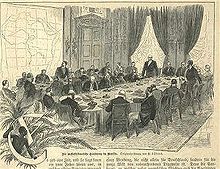 The Berlin Conference (1884) headed by Otto von Bismarck that regulated European colonization in Africa during the New Imperialism period
The Berlin Conference (1884) headed by Otto von Bismarck that regulated European colonization in Africa during the New Imperialism period
Colonial empires were the product of the European Age of Discovery from the 15th century. The initial impulse behind these dispersed maritime empires and those that followed was trade, driven by the new ideas and the capitalism that grew out of the Renaissance. Both the Portuguese Empire and Spanish Empire quickly grew into the first global political and economic systems with territories spread around the world.
Subsequent major European colonial empires included the French, Dutch, and British empires. The latter, consolidated during the period of British maritime hegemony in the 19th century, became the largest empire in history because of the improved transportation technologies of the time. At its height, the British Empire covered a quarter of the Earth's land area and comprised a quarter of its population. By the 1860s, the Russian Empire – continued as the Soviet Union – became the largest contiguous state in the world, and the latter's main successor, Russia, continues to be so to this day. Despite having "lost" its Soviet periphery, Russia has 9 time zones, stretching slightly over half the world's longitude.
The peace would only last until the Ottoman Empire had declined enough to become a target for the others. (See History of the Balkans.) This instigated the Crimean War in 1854 and began a tenser period of minor clashes among the globe-spanning empires of Europe that set the stage for the First World War. It changed a third time with the end of the various wars that turned the Kingdom of Sardinia and the Kingdom of Prussia into the Italian and German nation-states, significantly changing the balance of power in Europe. From 1870, the Bismarckian hegemony on Europe put France in a critical situation. It slowly rebuilt its relationships, seeking alliances with Russia and Britain, to control the growing power of Germany. In this way, two opposing sides formed in Europe, improving their military forces and alliances year-by-year.
World Wars and Cold War
See also: Twentieth centuryThe "short twentieth century", from 1914 to 1991, sees the First World War, the Second World War and the Cold War, including the rise and fall of Nazi Germany and of the Soviet Union. These disastrous events spell the end of the European Colonial empires and initiated widespread decolonisation. The collapse of the Soviet Union in 1989 to 1991 leaves the United States as the world's single superpower and triggers the fall of the Iron Curtain, the reunification of Germany and an accelerated process of a European integration that is ongoing.
World Wars
Main articles: World War I, Russian Revolution (1917), Treaty of Versailles, Great Depression, and World War IIAfter the relative peace of most of the 19th century, the rivalry between European powers exploded in 1914, when the First World War started. Over 60 million European soldiers were mobilised from 1914–1918.[49] On one side were Germany, Austria-Hungary, the Ottoman Empire and Bulgaria (the Central Powers/Triple Alliance), while on the other side stood Serbia and the Triple Entente – the loose coalition of France, the United Kingdom and Russia, which were joined by Italy in 1915, Romania in 1916 and by the United States in 1917. Despite the defeat of Russia in 1917 and the collapse of the Eastern Front (the war was one of the major causes of the Russian Revolution, leading to the formation of the socialist Soviet Union), the Entente finally prevailed in the autumn of 1918.
In the Treaty of Versailles (1919) the winners imposed relatively hard conditions on Germany and recognised the new states (such as Poland, Czechoslovakia, Hungary, Austria, Yugoslavia, Finland, Estonia, Latvia, Lithuania) created in central Europe out of the defunct German, Austro-Hungarian and Russian empires, supposedly out of national self-determination. Most of those countries engaged in local wars, the largest of them being the Polish-Soviet War (1919–1921). In the following decades, fear of communism and the Great Depression of 1929–1933 led to the rise of extreme nationalist governments – sometimes loosely grouped under the category of fascism – in Italy (1922), Germany (1933), Spain (after a civil war ending in 1939) and other countries such as Hungary (1944), Romania (1940) and Slovakia (1939).
After allying with Mussolini's Italy in the "Pact of Steel" and signing a non-aggression pact with the Soviet Union, the German dictator Adolf Hitler started the Second World War on 1 September 1939 attacking Poland and following a military build-up throughout the late 1930s. After initial successes (mainly the conquest of western Poland, much of Scandinavia, France and the Balkans before 1941) the Axis powers began to over-extend themselves in 1941. Hitler's ideological foes were the Communists in Russia but because of the German failure to defeat the United Kingdom and the Italian failures in North Africa and the Mediterranean the Axis forces were split between garrisoning western Europe and Scandinavia and attacking Africa. Thus, the attack on the Soviet Union (which together with Germany had partitioned central Europe in 1939–1940) was not pressed with sufficient strength. Despite initial successes, the German army was stopped close to Moscow in December 1941.
Over the next year the tide was turned and the Germans started to suffer a series of defeats, for example in the siege of Stalingrad and at Kursk. Meanwhile, Japan (allied to Germany and Italy since September 1940) attacked the British in Southeast Asia and the United States in Hawaii on 7 December 1941; Germany then completed its over-extension by declaring war on the United States. War raged between the Axis Powers (Germany, Italy, and Japan) and the Allied Forces (British Empire, Soviet Union, and the United States). Allied Forces won in North Africa, invaded Italy in 1943, and invaded occupied France in 1944. In the spring of 1945 Germany itself was invaded from the east by the Soviet Union and from the west by the other Allies respectively; After Red Army conquered the Reichstag in Berlin, Hitler committed suicide and Germany surrendered in early May ending the war in Europe.
This period was marked also by industrialised and planned genocide. The Nazis began the systematic genocide of over 11 million people, including the majority of the Jews of Europe and Gypsies as well as millions of Polish and Soviet Slavs. The Soviet system of forced labour, expulsions and allegedly engineered famine had a similar death toll. During and after the war millions of civilians were affected by forced population transfers.
Cold War
The First World War and especially the Second World War ended the pre-eminent position of western Europe. The map of Europe was redrawn at the Yalta Conference and divided as it became the principal zone of contention in the Cold War between the two power blocs, the Western countries and the Communist bloc. The United States and Western Europe (United Kingdom, France, Italy, Netherlands, West Germany, etc.) established the NATO alliance as a protection against a possible Soviet invasion. Later, the Soviet Union and its satellites in Europe (Bulgaria, Czechoslovakia, East Germany, Hungary, Poland, and Romania) established the Warsaw Pact as a counterpoint to NATO.
Meanwhile, western European countries slowly began a process of political and economic integration, with its aim to unite Europe and prevent another wars. This process included organisations such as the European Coal and Steel Community, which grew and evolved into the European Union, and the Council of Europe. The Solidarność movement in the 1980s weakened the Communist government in Poland. At the time the Soviet leader Mikhail Gorbachev initiated perestroika and glasnost, which weakened Soviet influence in Europe, particularly in the USSR. In 1989 the berlin Wall came down and the satellites threw off Communist control. In 1990 the Federal Republic of Germany had absorbed East Germany, after making large cash payments to the USSR. In 1991 the Communist Party in Moscow collapsed, ending the USSR, which split into fifteen independent states. The largest, Russia, took the Soviet Union's seat on the United Nations Security Council. The most violent breakup happened in Yugoslavia, in the Balkans. Four (Slovenia, Croatia, Bosnia and Herzegovina and Macedonia) out of six Yugoslav republics declared independence and for most of them a violent war ensued, in some parts lasting until 1995. In 2006 Montenegro seceded and became an independent state. In the post–Cold War era, NATO and the EU have been gradually admitting most of the former members of the Warsaw Pact.
Looking at the half century after the war historian Walter Laquer concluded:
- "The postwar generations of European elites aimed to create more democratic societies. They wanted to reduce the extremes of wealth and poverty and provide essential social services in a way that prewar generations had not. They had had quite enough of unrest and conflict. For decades many Continental societies had more or less achieved these aims and had every reason to be proud of their progress. Europe was quiet and civilized. Europe’s success was based on recent painful experience: the horrors of two world wars; the lessons of dictatorship; the experiences of fascism and communism. Above all, it was based on a feeling of European identity and common values—or so it appeared at the time."[50]
Recent history
Germans standing on top of the Berlin Wall at the Brandenburg Gate, November 1989; it would begin to be torn apart in the following days.
Following the end of the Cold War, the European Economic Community pushed for closer integration, cooperation in foreign and home affairs and started to increase its membership into the neutral and former communist countries. In 1993, the Maastricht Treaty established the European Union, succeeding the EEC and furthering political cooperation. The neutral countries of Austria, Finland and Sweden acceded to the EU and those that didn't join were tied into the EU's economic market via the European Economic Area. These countries also entered the Schengen Agreement which lifted border controls between member states.[51]
Another major innovation in the Maastricht Treaty was the creation of a single currency for most EU members. The euro was created in 1999 and replaced all previous currencies in 2002. The most notable exception to the currency union was the United Kingdom which also did not participate in the Schengen Agreement.
However, the EU's desire to work on foreign policy was undermined due to its failure to act during the Yugoslav wars and its division over whether to support the United States in the Iraq War. European NATO countries faced frequent criticism from the United States for not spending enough on the military and for not sending enough troops to support the NATO war in Afghanistan. Europe meanwhile decided to reap the benefits of its post–Cold War peace dividend and instead support the development of international law, for example through the International Criminal Court.
In 2004, the EU enlarged to include 10 new countries, eight developing former-communist countries (including three which were part of the Soviet Union itself along with Malta and the divided island of Cyprus. These would be followed by another two former-communist countries in 2007. NATO likewise expanded to include these countries, despite protestations from Russia which was growing more assertive. Russia engaged in a number of bilateral disputes about gas supplies with Belarus and Ukraine which endangered gas supplies to Europe. Russia also engaged in a minor war with Georgia in 2008.
However, with the influx of new members in 2004 together with awarding Turkey candidate status, public opinion in the EU turned against enlargement. This came out in part with the rejection of the European Constitution in referendums in France and the Netherlands. The constitution's replacement, the Treaty of Lisbon, was also voted down by the Irish before they reversed their decision in 2009. This led to the period between up to 2009 being dominated by "institutional navel gazing" by the EU and a rise in euroskepticism in some states. The Lisbon Treaty did however enhance the EU's capacity for foreign policy action.
Opposition to Turkish membership of the EU developed parallel to an increasing unease as to how Europe deals with Islam. Al Qaeda inspired attacks in London and Madrid, together with a perception that Europe's large Muslim minority was not integrating, contributed to a backlash in some countries. Belgium enacted a ban on the Burqa, also pursed by France while Switzerland banned minarets. Danish publication of cartoons portraying Islamic prophet Muhammad further damaged relations with Europe's Muslim population and the Islamic world at-large.
In 2008, the EU's eurozone entered its first recession, sparking a debate about possible economic collapse. It agreed to set up a bail out mechanism and study proposals for more fiscal integration. Greece (as well as the UK, Portugal, Spain, Italy, and Ireland) has high amounts of debt. However, in May 2010, the German parliament agreed to loan 22.4 billion euros to Greece over three years, with the stipulation that Greece follow strict austerity measures. See Eurozone debt crisis.
Timeline
- 700 BC: Epic poem Iliad by Homer, earliest account on the continent.
- 440 BC: Herodotus defends the Athenian political freedom in the Histories.
- 323 BC: Alexander the Great dies and his Macedonian Empire fragments.
- 44 BC: Julius Caesar is murdered. The Roman Republic drawing to a close.
- 27 BC: Establishment of the Roman Empire under Octavian.
AD
- 293: Diocletian founded the Tetrarchy.
- 330: Constantine makes Constantinople into his capital, a new Rome.
- 365: A single catastrophic earthquake near Crete in 365 or an amalgamation of a number of earthquakes between 350 and 450 occurs.
- 395: Following the death of Theodosius I, the Empire is permanently split into eastern and western halves.
- 476: Odoacer captures Ravenna and the Western Roman Empire ends.
- 597: Christianization of Anglo-Saxon England
- 527: Justinian I is crowned emperor of Byzantium. Corpus Juris Civilis, Digest (Roman law).
- 600: Saint Columbanus uses the term "Europe" in a letter.
- 655: Jus patronatus.
- 732: Battle of Tours, the Franks stop the advance of Arabs into Europe.
- 800: Coronation of Charlemagne as Holy Roman Emperor.
- 813: Third Council of Tours: Priests are ordered to preach in the native language of the population.
- 843: Treaty of Verdun.
- 863: Saints Cyril and Methodius arrive in Great Moravia.
- 872: Unification of Norway.
- 895: Hungarian people led by Árpád start to settle in the Carpathian Basin.
- 983: Otto III became the first ruling "King of the Romans", which meant "future Emperor".
- 1054: Start of the East-West Schism, which divides the Christian church for centuries.
- 1066: Successful Norman Invasion of England by William the Conqueror.
- 1095: Pope Urban II calls for the First Crusade.
- 12th century: The 12th century in literature saw an increase in texts. Renaissance of the 12th century.
- 1128: Battle of São Mamede, formation of Portuguese sovereignty.
- 1248: Pope Innocent IV gave the unique privilege of using the Glagolitic alphabet in the liturgy.
- 1303: The period of the Crusades is over.
- 1309–1378: The Avignon Papacy
- 1315–1317: The Great Famine of 1315–1317 in Northern Europe
- 1341: Petrarch, the "Father of Humanism", becomes the first Poet Laureate since antiquity.
- 1337–1453: The Hundred Years War
- 1340: Black Death kills a third of Europe's population.
- 1439: Johannes Gutenberg invents first printing press starting the Printing Revolution
- 1453: Fall of Constantinople to the Ottoman Turks.
- 1492: Christopher Columbus lands in the New World, the Reconquista is completed in the Iberian Peninsula
- 1497: Vasco da Gama departs to India starting direct trade with Asia.
- 1498: Leonardo da Vinci paints The Last Supper in Milan, as the Renaissance flourishes.
- 1508: Maximilian I the last ruling "King of the Romans" and the first "elected Emperor of the Romans".
- 1517: Martin Luther nails his demands for Reformation to the door of the church in Wittenberg.
- 1519: Ferdinand Magellan begins first global circumnavigation. Expedition returns 1522.
- 1519: Hernán Cortés begins conquest of Mexico for Spain.
- 1532: Francisco Pizarro begins conquest of Peru for Spain.
- 1543: Nicolaus Copernicus. De revolutionibus orbium coelestium (On the Revolutions of the Celestial Spheres).
- 1547: Assumption of the title Tsardom of Russia.
- 1582: The introduction of Gregorian calendar.
- 1608: Hans Lippershey designs first practical telescope
- 1610: Galileo Galilei discovers the moons of Jupiter.
- 1648: The Peace of Westphalia ends the Thirty Years' War.
- 1687: Isaac Newton published Principia Mathematica.
- 1699: Treaty of Karlowitz.
- 1707: The Kingdom of Great Britain is formed by the union of England and Scotland.
- 1712: Thomas Newcomen invents first practical steam engine which begins Industrial Revolution in England.
- 1721: Foundation of the Russian Empire.
- 1775: James Watt invents a new efficient steam engine accelerating the industrial revolution in England.
- 1784: Immanuel Kant published Answering the Question: What Is Enlightenment?. Age of Enlightenment.
- 1786: The Duchy of Tuscany becomes the first state in the modern era to completely abolish the death penalty.
- 1789: The French Revolution.
- 1807: The Slave Trade Act was passed by the British Parliament on 25 March 1807, making the slave trade illegal throughout the British Empire.
- 1815: Following the defeat of Napoleon Bonaparte by the Duke of Wellington at the Battle of Waterloo the Treaty of Vienna is signed.
- 1825: George Stephenson opens the Stockton and Darlington Railway the first steam train railway for passenger traffic in the world.
- 1833: Slavery abolished throughout the British Empire
- 1836: Louis Daguerre invents first practical photographic method - in effect the first camera.
- 1838: SS Great Western the first steamship purpose-built for regularly scheduled trans-Atlantic crossings enters service.
- 1848: Revolutions of 1848 and The Communist Manifesto.
- 1852: Start of Crimean War to 1855.
- 1861: Unification of Italy after victories by Guiseppe Garibaldi
- 1866: First commercially successful transatlantic telegraph cable was successfully completed.
- 1859: Charles Darwin publishes On the Origin of Species.
- 1860s: Russia emancipates its serfs and Karl Marx completes the first volume of Das Kapital.
- 1870: Franco-Prussian War and the fall of the Second French Empire.
- 1871: Unification of Germany under the direction of Otto von Bismarck
- 1873: Panic of 1873 and the Long Depression begins.
- 1885: Karl Benz invents Benz Patent Motorwagen worlds first automobile.
- 1885: First permanent city-wide electrical tram system in Europe (Sarajevo).
- 1895: Auguste and Louis Lumière begin exhibitions of projected films before the paying public with their cinematograph, a portable camera, printer, and projector.
- 1898: The NW First Truck is manufactured.
- 1899: In Budapest is a 1.5 km long test track with three-phase electric power for electric railways put into operation.
- 1902: Guglielmo Marconi sends fist transatlantic Radio Transmission.
- 1905: Albert Einstein publishes his theory of special relativity and E = mc2.
- 1914: Archduke Franz Ferdinand of Austria is assassinated in Sarajevo and World War I begins.
- 1917: Vladimir Lenin and the Bolsheviks seize power in the Russian Revolution. The ensuing Russian Civil War lasts until 1922.
- 1918: End of World War I Germany defeated.
- 1922: Benito Mussolini and the Fascists take power in Italy.
- 1926: John Logie Baird gives the world's first demonstration of a working television system.
- 1933: Adolf Hitler and the Nazis take power in Germany
- 1936: Start of the Spanish Civil War to 1939
- 1939: Adolf Hitler and Joseph Stalin agree partition of Poland in Molotov-Ribbentrop Pact
- 1939: Germany invades Poland starting World War II
- 1940: Great Britain under Winston Churchill become the last nation to hold out against the Nazis after winning the Battle of Britain
- 1941: Germany invades the Soviet Union in Operation Barbarossa.
- 1942: Nazi Germany commences Final Solution an attempted genocide of the Jews.
- 1945: World War II ends with Europe in ruins and Germany defeated.
- 1947: British Empire begins to be voluntarily dismantled with the granting of independence to India and Pakistan.
- 1949: NATO established to defend western democracy from Soviet Communism.
- 1950: The Schuman declaration begins European unity
- 1954: French Empire begins to be dismantled after suffering defeat at Dien Bien Phu in Vietnam.
- 1956: Hungarian Uprising crushed by Soviet tanks.
- 1957: Treaties of Rome establish the European Economic Community from 1958.
- 1968: The Prague Spring crushed by Soviet tanks. The Club of Rome is founded.
- 1980: The Solidarność movement under Lech Walesa begin opposition to the Communist government in Poland.
- 1985: Mikhail Gorbachev becomes leader of Soviet Union and begins reforms which inadvertently lead to the collapse of Communism and USSR.
- 1989: Communism overthrown by popular uprisings in all the Warsaw Pact countries except the USSR. The Berlin Wall is torn down.
- 1990: German reunification
- 1991: Breakup of Yugoslavia
- 1991: Dissolution of the Soviet Union
- 1991: Tim Berners-Lee invents the World Wide Web commonly known as the "internet".
- 1993: Treaty of Maastricht establishes the European Union.
- 2004: The European Union takes in Slovenia, Hungary, the Czech Republic, Slovakia, Poland, Lithuania, Latvia, Estonia, Cyprus and Manta.
- 2007: The European Union takes in Romania and Bulgaria
See also
- English and French monarchs overlap chart
- Historic list of cities of Europe
- History of Western civilization
- Predecessors of sovereign states in Europe
- Timeline of European nations
References
- ^ "The Great Famine (1315–1317) and the Black Death (1346–1351)". Vlib.us. http://www.vlib.us/medieval/lectures/black_death.html. Retrieved 2010-01-31.
- ^ "Thirty Years War". Historylearningsite.co.uk. 2007-03-30. http://www.historylearningsite.co.uk/population_30YW.htm. Retrieved 2010-01-31.
- ^ Richard J. Mayne. "history of Europe:: The Middle Ages – Britannica Online Encyclopedia". Britannica.com. http://www.britannica.com/eb/article-58260/history-of-Europe. Retrieved 2009-04-18.
- ^ Steven Kreis (2006-10-11). "The Origins of the Industrial Revolution in England". Historyguide.org. http://www.historyguide.org/intellect/lecture17a.html. Retrieved 2010-01-31.
- ^ "Serf. A Dictionary of World History". Encyclopedia.com. http://www.encyclopedia.com/doc/1O48-serf.html. Retrieved 2010-01-31.
- ^ Chapman 1981, pp. 40–51.
- ^ Gimbutas 1976.
- ^ Haarmann, Harald: "Geschichte der Schrift", C.H. Beck, 2002, ISBN 3406479987, p. 20
- ^ http://www.msnbc.msn.com/id/26839697/ns/technology_and_science-science/t/years-ago-neolithic-optical-art-flourished/
- ^ Fulford, Robert (17 March 2009). "What we don't know can't hurt us". National Post Company (Toronto: National Post). ISSN 1486-8008. http://www.robertfulford.com/2009-03-17-museums.html. Retrieved 17 May 2009.
- ^ Mallory, James P (1989). In search of the Indo-Europeans: language, archaeology and myth. London: Thames and Hudson. ISBN 050005052X. OCLC 246601873.
- ^ "Ancient Crete" in Oxford Bibliographies Online: Classics, offers a scholarly guide to the academic literature on this topic.
- ^ Durant, The Life of Greece (The Story of Civilization Part II, (New York: Simon & Schuster) 1939:11.
- ^ Hammond, N.G.L. (1976). Migrations and invasions in Greece and adjacent areas. Park Ridge, N.J.: Noyes P.. pp. 139. ISBN 9780815550471. http://books.google.com/books?ei=ltOgTfe6CMrZsgadzYjjAQ&ct=result&hl=el&id=O9saAAAAYAAJ&dq=epirus%2Bmycenaean%2Bparga&q=%22Moreover%2C+in+this+area+a+small+tholos-tomb+with+Mycenaean+pottery+of+III+B+style+and+a+Mycenaean+acropolis+have+been+reported+at+Kiperi+near+Parga%2C+and+another+Mycenaean+acropolis+lay+above+the+Oracle+of+the+Dead+on+the+hill+called+%22#search_anchor.
- ^ Tandy, p. xii. "Figure 1: Map of Epirus showing the locations of known sites with Mycenaean remains"; Tandy, p. 2. "The strongest evidence for Mycenaean presence in Epirus is found in the coastal zone of the lower Acheron River, which in antiquity emptied into a bay on the Ionian coast known from ancient sources as Glykys Limin (Figure 2-A)."
- ^ Borza, Eugene N. (1990). In the shadow of Olympus : the emergence of Macedon ([Nachdr.] ed.). Princeton, NJ: Princeton University Press. pp. 64. ISBN 9780691008806. http://books.google.com/books?id=614pd07OtfQC&pg=PA64&dq=macedonia%2Bmycenaean&hl=el&ei=e9SgTeXjMcXrsgao8PT8AQ&sa=X&oi=book_result&ct=result&resnum=5&ved=0CDwQ6AEwBA#v=snippet&q=%22The%20existence%20of%20a%20Late%20Bronze%20Age%20Mycenaean%20settlement%20in%20the%20Petra%20not%20only%20confirms%20its%20importance%20as%20a%20route%20from%20an%20early%20period%2C%20but%20also%20extends%20the%20limits%20of%20Mycenaean%20settlement%20to%20the%20Macedonian%20frontier.%22&f=false.
- ^ Aegeobalkan Prehistory – Mycenaean Sites
- ^ The Synchronisation of Civilisations in the eastern Mediterranean in the Second Millennium B.C. III, Proceedings of the SCIEM 2000 – 2nd EuroConference, Vienna, 28th of May – 1st of June 2003
- ^ Use and appreciation of Mycenaean pottery in the Levant, Cyprus and Italy, Gert Jan van Wijngaarden, Amsterdam Archaeological Studies
- ^ The Mycenaeans and Italy: the archaeological and archaeometric ceramic evidence, University of Glasgow, Department of Archaeology
- ^ Emilio Peruzzi, Mycenaeans in early Latium, (Incunabula Graeca 75), Edizioni dell'Ateneo & Bizzarri, Roma, 1980
- ^ Boston University – The Historical Society
- ^ Amber object bearing Linear B symbols, from Freising district, Germany, excavations in the years 1994–1997
- ^ The Ancient Greeks: An Introduction, Stephanie Lynn Budin, Oxford University press
- ^ The Celtic Encyclopedia
- ^ The Encyclopedia Americana, Volume 13
- ^ Bryan Avery Feuer, Mycenaean civilization: an annotated bibliography through 2002, McFarland & Co Inc, 2004
- ^ "Socrates". 1911 Encyclopaedia Britannica. 1911. http://www.1911encyclopedia.org/Socrates_%28philosopher%29. Retrieved 2008-03-04.
- ^ Bowersock, "The Vanishing Paradigm of the Fall of Rome" Bulletin of the American Academy of Arts and Sciences 49.8 (May 1996:29–43) p. 31.
- ^ Hunt, Lynn; Thomas R. Martin, Barbara H. Rosenwein, R. Po-chia Hsia, Bonnie G. Smith (2001). The Making of the West, Peoples and Cultures, Volume A: To 1500. Bedford / St. Martins. p. 256. ISBN 0-312-18365-8. OCLC 45837131 229955165 45837131.
- ^ Encyclopædia Britannica. "history of Europe:: The Middle Ages – Britannica Online Encyclopedia". Britannica.com. http://www.britannica.com/eb/article-58260/history-of-Europe. Retrieved 2010-01-31.
- ^ Fletcher, Banister, "Sir Banister Fletcher's A History of Architecture", Architectural Press; 20 edition (11 September 1996), ISBN 978-0750622677, pp 172
- ^ The History of the Bubonic Plague[dead link]
- ^ "Scientists Identify Genes Critical to Transmission of Bubonic Plague". .niaid.nih.gov. Archived from the original on October 7, 2007. http://web.archive.org/web/20071007012619/http://www3.niaid.nih.gov/news/newsreleases/1996/plague.htm. Retrieved 2010-01-31.
- ^ Ralph R. Frerichs. "An Empire's Epidemic". Ph.ucla.edu. http://www.ph.ucla.edu/EPI/bioter/anempiresepidemic.html. Retrieved 2010-01-31.
- ^ "Justinian's Flea". Justiniansflea.com. http://www.justiniansflea.com/events.htm. Retrieved 2010-01-31.
- ^ "The Great Arab Conquests". International Herald Tribune. 2009-03-29. http://www.iht.com/articles/2008/01/04/arts/idbriefs5H.php. Retrieved 2010-01-31.
- ^ Events used to mark the period's beginning include the sack of Rome by the Goths (410), the deposition of the last western Roman Emperor (476), the Battle of Tolbiac (496) and the Gothic War (535–552). Particular events taken to mark its end include the founding of the Holy Roman Empire by Otto I the Great (962), the Great Schism (1054) and the Norman conquest of England (1066).
- ^ The Destruction of Kiev
- ^ Cantor, p. 480.
- ^ Translation of the Treaty of Tordesillas by Frances Gardiner Davenport
- ^ MacKnight, CC (1976). The Voyage to Marege: Macassan Trepangers in Northern Australia. Melbourne University Press.
- ^ Euan Cameron, The European Reformation (1991)
- ^ "Conquest in the Americas". Conquest in the Americas. http://encarta.msn.com/encyclopedia_761575057_13/spain.html.
- ^ Thirty Years' War, Encyclopædia Britannica
- ^ "Germany – The Thirty Years' War – The Peace of Westphalia". Historymedren.about.com. 2009-11-02. http://historymedren.about.com/library/text/bltxtgermany16.htm. Retrieved 2010-01-31.
- ^ Business and Economics. Leading Issues in Economic Development, Oxford University Press US. ISBN 0-19-511589-9 Read it
- ^ Russell Brown, Lester. Eco-Economy, James & James / Earthscan. ISBN 1-85383-904-3 Read it
- ^ "The Treaty of Versailles and its Consequences". Archived from the original on June 12, 2008. http://web.archive.org/web/20080612045049/http://www.jimmyatkinson.com/papers/versaillestreaty.html. Retrieved 2010-01-31.
- ^ Walter Laqueur, "The Slow Death of Europe," The National Interest August 16, 2011 online
- ^ "A Europe without frontiers". Europa (web portal). http://europa.eu/abc/history/1990-1999/index_en.htm. Retrieved 2007-06-25.
Bibliography
Surveys
- McKay, John P. et al. A History of Western Society (2 vol 2010) 1300pp
- Roberts, J. M. The History of Europe (1997)
Classical
- Boardman, John, et al. eds. The Oxford History of Greece and the Hellenistic World (2nd ed. 2002) 520pp
- Boardman, John, et al. eds. The Oxford History of the Roman World(2001)
- Cartledge, Paul. The Cambridge Illustrated History of Ancient Greece (2002)
Late Roman
- Heather, Peter. Empires and Barbarians: The Fall of Rome and the Birth of Europe (Oxford University Press; 2010); 734 pages; Examines the migrations, trade, and other phenomena that shaped a recognizable entity of Europe in the first millennium.
- Jones, A. H. M. The Later Roman Empire, 284-602: A Social, Economic, and Administrative Survey (2 Vol. 1964)
- Mitchell, Stephen. A History of the Later Roman Empire, AD 284-641: The Transformation of the Ancient World (2006)
Medieval
- Hanawalt, Barbara. The Middle Ages: An Illustrated History (1999)
- Holmes, George, ed. The Oxford Illustrated History of Medieval Europe (2001)
- Riddle, John M. A history of the Middle Ages, 300-1500 (2008)
Early Modern
- Blanning, T. C. W. The Culture of Power and the Power of Culture: Old Regime Europe 1660–1789 (2003)
- Rice, Eugene F. The Foundations of Early Modern Europe, 1460–1559 (2nd ed. 1994) 240pp
- Merriman, John. A History of Modern Europe: From the Renaissance to the Present (3rd ed. 2009, 2 vol), 1412 pp
- Wiesner, Merry E. Early Modern Europe, 1450–1789 (Cambridge History of Europe) (2006)
19th century
- Anderson, M.S. The Ascendancy of Europe: 1815–1914 (3rd ed. 2003)
- Blanning, T. C. W. ed. The Nineteenth Century: Europe 1789–1914 (Short Oxford History of Europe) (2000) 320pp
- Grab, Alexander. Napoleon and the Transformation of Europe (2003),
- Steinberg, Jonathan. Bismarck: A Life (2011)
- Salmi, Hannu. 19th Century Europe: A Cultural History (2008)
- Taylor, A. J. P. The Struggle for Mastery in Europe: 1848-1918 (Oxford History of Modern Europe) (1955), diplomatic history
20th century
- Brose, Eric Dorn. A History of Europe in the Twentieth Century (2004) 548pp
- Davies, Norman. No Simple Victory: World War II in Europe, 1939–1945 (2008)
- Dear, I. C. B. and M. R. D. Foot, eds. The Oxford Companion of World War II (2006)
- Judt, Tont. Postwar: A History of Europe Since 1945 (2006)
- Mazower, Mark. Dark Continent: Europe's Twentieth Century (2000) 512pp
- Paxson, Robert. Europe in the 20th Century (1996)
- Weinberg, Gerhard L. A World at Arms: A Global History of World War II (2005)
Agriculture and economy
- Bakels, C. C. The Western European Loess Belt: Agrarian History, 5300 BC – AD 1000 (2009)
- Broadberry, Stephen, and Kevin H. O'Rourke, eds. The Cambridge Economic History of Modern Europe (2 vol 2010), 1700 to present
- Dovring, Folke, ed. Land and labor in Europe in the twentieth century: a comparative survey of recent agrarian history . 1965. 511 pp
- Gras, Norman. A history of agriculture in Europe and America, (1925). free online edition
- Murray, Jacqueline. The First European Agriculture (1970)
- Pounds, N.J.G. An Historical Geography of Europe (2 vol 2009) from 450BC to 1840
- Slicher van Bath, B. H. The agrarian history of Western Europe, AD 500-1850 (1966)
Religion
- MacCulloch, Diarmaid. Christianity: The First Three Thousand Years (2011)
Ideas and science
- Heilbron, John L., ed. The Oxford Companion to the History of Modern Science (2003)
- Outhwaite, William. The Blackwell Dictionary of Modern Social Thought (2003).
- Wiener, Philip P. Dictionary of the History of Ideas (5 vol 1973)
Social
- Stearns, Peter N., ed. Encyclopedia of European Social History (6 vol 2000), 3000 pp
Warfare
- Archer, Christon I.; John R. Ferris, Holger H. Herwig. World History of Warfare (2002)
- Paret, Peter, ed. Makers of Modern Strategy (1986)
Women
- Anderson, Bonnie S. and Judith P. Zinsser. A History of Their Own: Women in Europe from Prehistory to the Present (2nd ed 2000)
- Offen, Karen. "Surveying European Women's History since the Millenium: A Comparative Review," Journal of Women's History Volume 22, Number 1, Spring 2010 DOI: 10.1353/jowh.0.13
External links
- Maps of Europe Wikimedia Commons
- An Atlas of European History Wikimedia Commons
- European History Primary Sources Online access to primary sources for historians
Categories:
Wikimedia Foundation. 2010.


